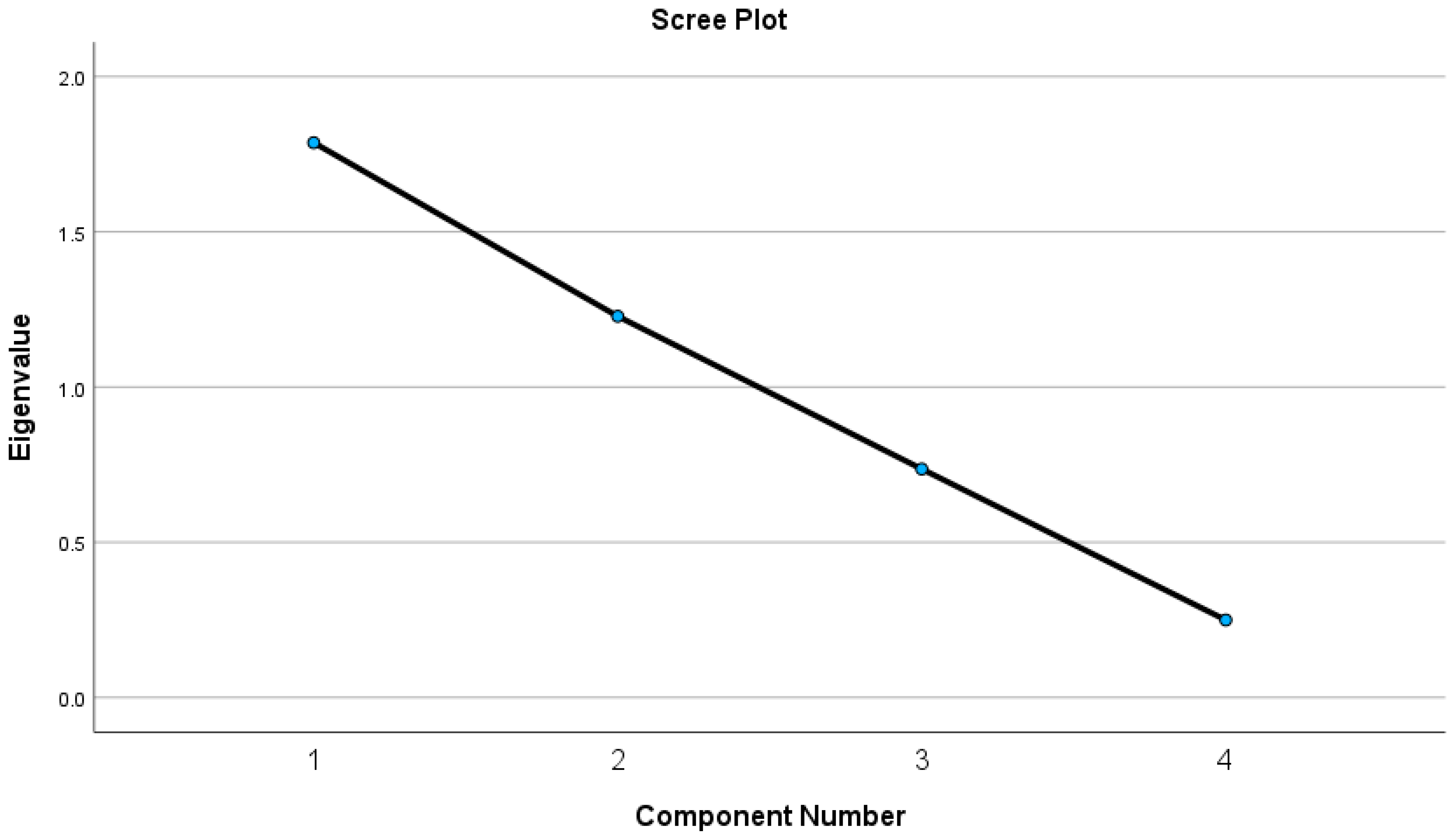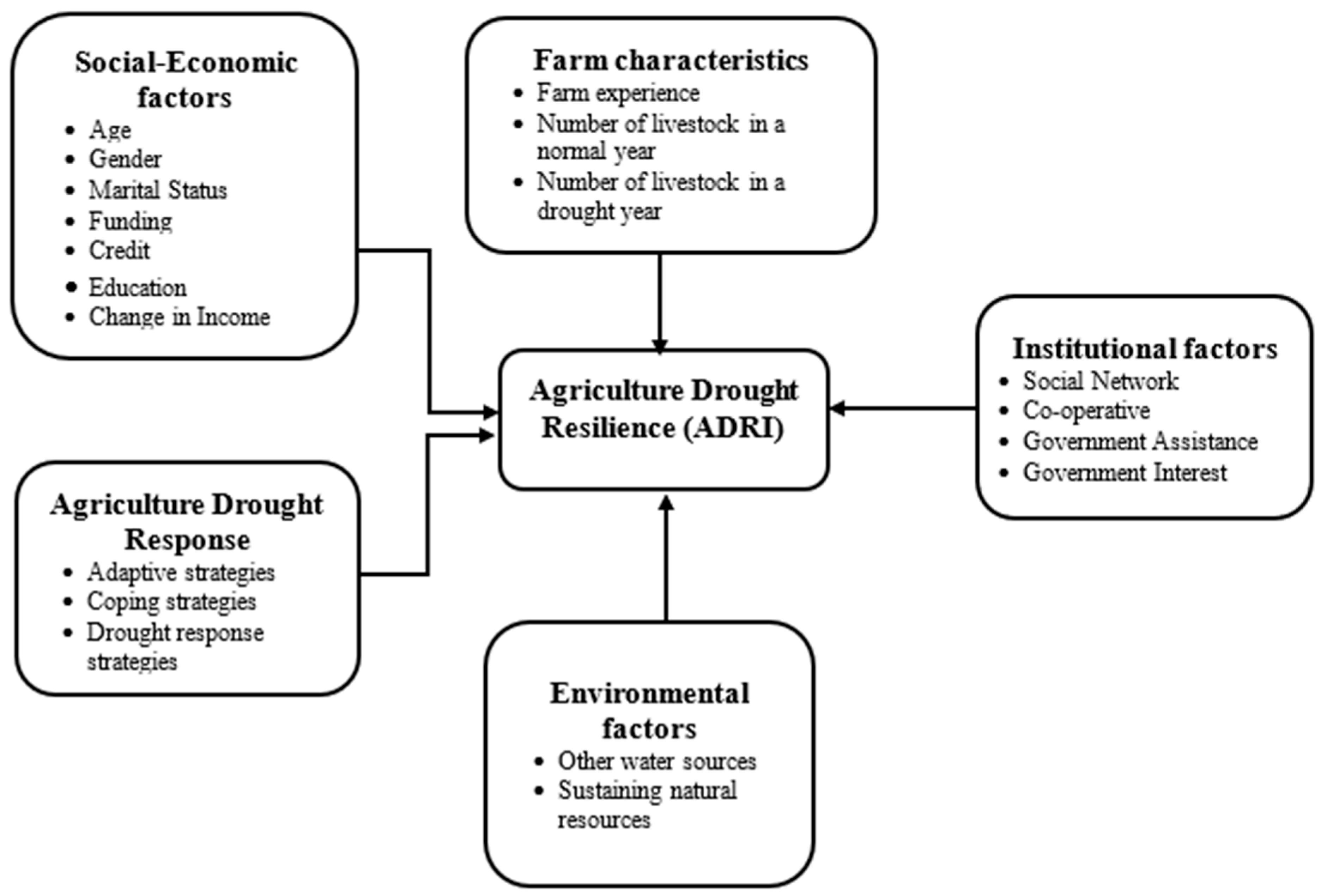This subsection presents the results from the empirical analysis of the ADRI and the Probit Model.
3.3.1. Agricultural Drought Resilience Index (ADRI)
Table 5 shows the correlation matrix of variables utilised when constructing ADRI. The highest correlation exists (0.722) between commercial livestock production in a normal year and commercial livestock production in a drought year. A moderate correlation existed between months a farmer is financially stable in a drought year (CFD) and months a farmer is financially stable in a normal year (CFD) (0.343).
Bartlett’s Test of Sphericity was conducted to evaluate the suitability of the data for PCA. This test examines the hypothesis that the variables used in PCA are not intercorrelated.
Table 6 presents the results of Bartlett’s Test of Sphericity. The findings indicate an approximated chi-square value of 334.674 with 6 degrees of freedom, with the null hypothesis, stating that the intercorrelation matrix is an identity matrix, rejected. This suggests that the variable reduction is inappropriate, as the intercorrelation matrix does not stem from a population. Since the observed intercorrelations resulted from sampling error, the variables are sufficiently correlated to justify the application of PCA.
Kaiser–Meyer–Olkin’s (KMO) measure of sampling adequacy was also employed to assess the suitability of Principal Component Analysis (PCA). The results indicated a KMO value of 0.5, which meets the threshold for appropriateness. A higher KMO value suggests a significant degree of shared variance among the variables, indicating that PCA will likely yield components that explain a substantial amount of variance. Therefore, the dataset met all the requirements for both the KMO and Bartlett’s Test of Sphericity, confirming its suitability for dimension reduction through PCA.
Table 7 presents the results of the unrotated PCA. Each variable has been standardised to have a mean of zero and a variance of one. The total variance to be explained across the four variables is 4. A variable is helpful if it accounts for more than one unit of variance, corresponding to an eigenvalue greater than one. The first principal component explains approximately 44% of the total variance, while the second, third, and fourth components account for 33%, 16%, and 7%, respectively.
Components were compared to prior expectations to choose the variable for constructing the ADRI. It is imperative to obtain the eigenvectors to select the variable to be used. The study used the Kaiser criterion (eigenvalue > 1) to determine the number of factors to retain. The scree plot in
Appendix A,
Figure A1, shows the eigenvalues of each component. The communalities for each variable retained in the PCA were obtained based on the first two principal components, which explain over 77% of the total variance (see
Table A1 in the
Appendix A).
Table 8 presents the value for the intersection of each variable and component that represents the eigenvector or component loadings. The first and second principal components were used to construct the ADRI.
Table 9 shows the ADRI for commercial livestock farmers in the study area. The resilience index for the average household was calculated at 0.000016, indicating that commercial livestock farming households in the Northern Cape Province are marginally resilient to agricultural drought. This implies that, on average, commercial livestock farmers have a minimal buffer against agricultural drought impacts, which could be sufficient to avoid significant vulnerability but lacks proactive long-term resilience. The results show that 67% of these households were not resilient to agricultural drought, while the remaining 33% were resilient. These findings suggest that most commercial livestock farmers do not have adequate strategies and resources to help mitigate the adverse effects of agricultural drought. This lack of resilience is concerning, especially considering that drought conditions are expected to continue or worsen due to climate change. The consequences are complex and far-reaching.
3.3.2. Probit Model
The coefficient/parameter estimates of the Probit Model, as presented in
Table 10, quantify the effect of each explanatory variable on fluctuations in the dependent variable (ADRI).
P-values were utilised to assess the importance of each explanatory variable’s effect on the response variable. Out of the 21 variables incorporated in the model, only eight explanatory variables proved significant. These include gender, educational attainment of Grade 12, presence of relative support, livestock numbers in normal years, livestock numbers in typical drought years, income fluctuations, capacity to maintain natural resources (indicated by the use of natural water sources during drought), and participation in social networks.
The model had a Pseudo R2 of 0.602, reflecting a high model fit to explain variability in drought resilience among commercial livestock farmers as explained by the regressors included. The Wald chi-square test was also significant at 1% (Prob > chi2 = 0.000), suggesting that at least one of the predictors is associated with resilience to agricultural drought. The results from the Probit Model estimation of factors influencing agricultural resilience among commercial livestock farming households revealed that the gender of the household head has a negative coefficient, significant at the 1% level. Specifically, male-headed households are 59% less likely to be resilient to agricultural drought than female-headed commercial livestock farmers. As authors, however, we believe that the data structure skewed this result. Since only two of the 123 household heads were female, the possibility that half or all of the female farmers were more resilient than half of the male farmers is high. Therefore, although statistically significant, we caution against the correctness of this result.
Education was found to significantly affect the agricultural resilience of commercial livestock farmers, given a coefficient of 1.305 and p < 0.06. Farmers with an education level of Grade 12 were more likely to be resilient to agricultural drought than farmers with less education than Grade 12.
The output for the marginal effect of education attainment represents a 0.165 change in the probability of being resilient, which entails that farmers who completed high school (Grade 12) were 17% more likely to be resilient to agricultural drought, holding other variables constant. Being educated with at least high school qualifications plays a significant role in improving decision-making abilities and accessing relevant farm and climate-related information to deal with drought risks. Farmers with more education are more likely to welcome and prioritise training programmes focused on drought-resistant farming methods.
Receiving support from relatives was found to have a positive coefficient of 1.210, which is significant at the 5% level (p < 0.031). This indicates that relative support significantly increases the likelihood of resilience to agricultural drought among commercial livestock farmers. The marginal effects reveal that farmers who received support from relatives during drought were 17% more likely to demonstrate resilience. This relative support is crucial because it allows farmers to access additional resources, such as financial aid, labour, and supplies, which can help mitigate potential losses during drought periods. Furthermore, it provides a support network for commercial farmers who may lack adequate assistance from the government or other institutions.
The variables representing the number of livestock in a typical year and during a drought year were found to be significant. An increase in livestock numbers was associated with a higher likelihood of resilience to agricultural drought (coefficient = 0.001, p < 0.01 for a normal year, and 0.001, p < 0.1 for a drought year). Furthermore, a significant positive relationship was identified between changes in farm income during normal and drought periods and the resilience of commercial livestock farmers (coefficient = 0.005, p < 0.05). The marginal effect suggests that even a slight increase in the income difference between normal and drought years enhances farmer resilience by 0.07%. This finding highlights that maintaining a substantial number of livestock can serve as an asset, enabling farmers to access additional resources such as financial aid to support adaptive strategies, thereby facilitating recovery during drought periods. The positive association indicates that smaller income fluctuations are indicative of greater resilience. This underscores the importance of income diversification strategies to mitigate the impacts of drought-related income volatility.
Furthermore, the availability of alternative water sources during drought conditions was found to have a statistically significant negative coefficient (coefficient = −3.066, p < 0.01). This indicates that commercial livestock farmers who depend on alternative natural water resources during drought periods exhibit a negative association with resilience. This finding contradicts the general expectation that water accessibility would enhance farmers’ capacity to irrigate pastures and thereby improve resilience. The negative coefficient suggests that agricultural drought compromises the sustainability of these water sources, as they become depleted due to excessive use and reduced water levels. Additionally, participation in social networks was observed to decrease resilience to agricultural drought (coefficient = 1.345, p < 0.05). The marginal effects reveal that commercial livestock farmers involved in social networks during drought were 19% less likely to demonstrate resilience to agricultural drought. This outcome also defies expectations, as engagement in social networks, such as farmer unions and other organised agricultural groups, is typically presumed to bolster resilience. We posit that this result may arise from the tendency of less resilient farmers to actively participate in organised agriculture and seek assistance during challenging times. Consequently, this finding exemplifies the post hoc ergo propter hoc fallacy, suggesting that while the results indicate reduced resilience due to social network involvement, the reality may be that high social network involvement is a consequence of low resilience.










